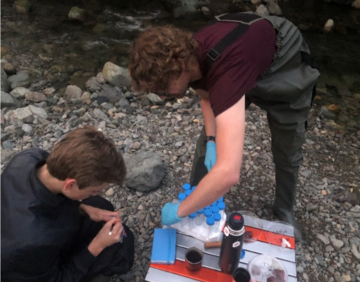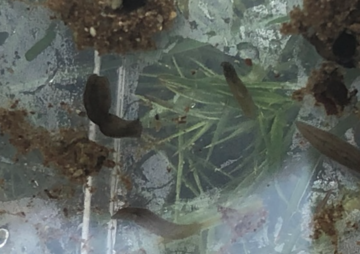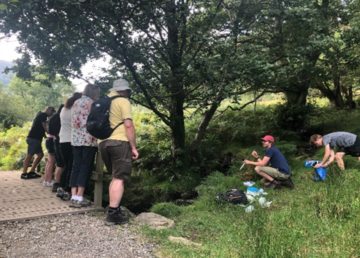Flatworm collection in the Lake District
Hello, I’m Robert, a physics 3rd year undergraduate at Oxford. I am currently partaking in a NERC undergraduate experience placement at the SalGo Team.
[SPA] Hola, soy Robert, un estudiante de 3er año en fisica en Oxford. Actualmente estoy realizando una estancia en el SalGo Team con financiacion del NERC undergraduate experience placement.
Recently I joined a research trip to the Lake District. The trip took place between 25/08 - 28/08. The objective was to collect freshwater flatworms (Polycelis spp.) to use in a calorie restriction project at the SalGo Team.
Recientemente me uní a una campaña de trabajo en el Lake District. El viaje tuvo lugar entre el 25 y 28 de Agosto. El objetivo era recolectar planarias (Polycelis spp.) para un proyecto en el que el SalGo Team está examinando el papel de la restrición calórica.
I’ll start at the beginning, where myself and Jacques (postdoc on the project) were battling bank holiday weekend induced train delays to arrive in Oxford on time, only to find Rob and Katrina were going to be late because they had to bake a cake. This seemed like a perfectly acceptable excuse, and by mid-afternoon we were on our way. A long journey followed, abated by Edinburgh Fringe comedy shows, and we arrived at our accommodation, YHA Helvellyn, around 8pm.
Empezaré por el principio, donde Jacques (postdoc en el proyecto) y yo tuvimos que navegar el retraso de trenes para llegar a Oxford a tiempo, inducido por le puente de vacaciones, para encontrar que Rob y Katrina llegaban tarde también debido a una tarta que estaban cocinando. Esa excusa fue por supuesto perfectamente aceptada, y alrededor de la media tarde ya estabamos de camino al campo. Tras un largo viaje hecho mas ameno por un programa de radio de comedia de Edinburgo, llegamos a nuestro alojamiento, en un hostal para la juventud en Helvelllyn, sobre las 8 de la noche.

Figure 1. Jacques in his waders, while Robert labels tubes to collect flatworms
Figura 1. Jacques en sus botas altas, mientras Robert etiqueta tubos para colectar planarias
After a quick meal (involving the delicious aforementioned cake) and some site-scoping for the following day, we went to bed. The lack of a party until the early hours was due to a decision, made largely out of my hands, to head out at 5am to start baiting (Figure 1). Flatworms are most active at night, so we left delectable calf liver in a nearby stream for them to enjoy. Sadly, the ungrateful flatworms did not show up and we trudged back for breakfast.
Tras una cena rápida (incluyendo una tarta deliciosa) y un poco de reconocimiento para el dia siguiente, nos fuimos a dormir. El postponer los festejos hasta el dia siguiente fue una decisión fuera de mi control, para podernos ir a poner cebos a las 5am (Figura 1). Las planarias tienden a estar mas activas por la noche, asi que dejamos trocitos de delicioso higado de ternera en el arroyo cercano. Desafortunadamente, las ingratas planarias no aparecieron y regresamos penosamente para el desayuno.

Figure 2. Several flatworms, with one (top-left) splitting
Figura 2. Varios gusanos planos, con una división (arriba a la izquierda)
With renewed vigour we drove to a series of nearby streams and found flatworms hiding under rocks in abundance. The Lake District is absolutely stunning, and I started to become a successful flatworm hunter, enjoying my first experience of fieldwork more and more. We even saw a flatworm splitting, showing off its regenerative properties (Figure 2). Little is known about the ecology of flatworms, so finding them was fairly ad-hoc, but this meant more time spent walking around Ullswater - I wasn’t complaining. I also found that an integral aspect of any fieldwork trip is responding to the variety of confused expressions from members of the public (Figure 3). Interestingly, most people assumed that what we were looking for was endangered. We gladly took the time to explain that flatworms are just incredibly cool.
Con renovado vigor, condujimos a una serie de arroyos cercanos y encontramos, ahora si, un montón de planarias escondidas bajo rocas. El Lake District es absolutamente impresionante, y comencé a convertirme en un exitoso cazador de planarias, disfrutando cada vez más de mi primera experiencia de trabajo de campo. Incluso vimos una fisión en una planaria, demostrando sus propiedades regenerativas (Figura 2). Lo cierto es que poco se sabe sobre la ecología de estas planarias, por lo que encontrarlas fue en si bastante ad-hoc, pero esto significó más tiempo para pasear por Ullswater. No me quejo, en absoluto. También descubrí que un aspecto integral de cualquier viaje de trabajo de campo es responder a la variedad de expresiones confusas de los miembros del público (Figura 3). Curiosamente, la mayoría de las personas asumieron que lo que estábamos buscando estaba en peligro. Con mucho gusto nos tomamos el tiempo necesario para explicar que las planarias realmente fascinantes.

Figure 3. Jacques and Robert explaining our research on flatworm calorie restriction to the general public at the Lake District
Figura 3. Jacques y Robert explican nuestra investigación sobre la restricción calórica en planarias al público en el Lake District
The following day, we went to the other side of Ullswater. We couldn’t find many flatworms in the first couple of streams, but this meant that there was time for Jacques and I to star in a drone cameo directed by Rob (for presentation purposes, stay tuned to research seminars). Later on, we found plenty of flatworms again and returned home victorious. I am grateful that they are easy(ish) to find and the fieldwork trip was deemed a success, so that we could all enjoy a bottle of (albeit Australian) wine in the evening.
Al día siguiente, fuimos al otro lado del lago Ullswater. No pudimos encontrar muchas planarias en las primeras dos excursiones, pero esto significó más tiempo para que Jacques y yo protagonizáramos un cameo de drones dirigido por Rob (para fines de presentación, estad atentos a los seminarios de investigación). En nuestra siguiente incursión encontramos muchas planarias y regresamos victoriosos a casa. Estoy agradecido de que las planarias sean tan relativamente fácil de encontrar. El trabajo de campo fue todo un éxito, por lo que todos pudimos disfrutar de una botella de vino australiano en nuestra ultima noche.
I am also happy to report that the majority of the nearly 1,000 individual flatworms that we collected at the Lake District appear to have made it home safely and have begun their acclimatisation process to laboratory conditions. In upcoming blogs, we will let you know how they are getting on in their new petry-dish homes.
También me complace informar que la mayoría de las casi 1,000 planarias que recolectamos en el Lake District parecen haber llegado a casa de manera segura y han comenzado su proceso de aclimatación a las condiciones de laboratorio. En los próximos blogs, os haremos saber cómo les está yendo en sus nuevos hogares de platillo.
Robert Pennman
Translated to Spanish by Rob S-G



